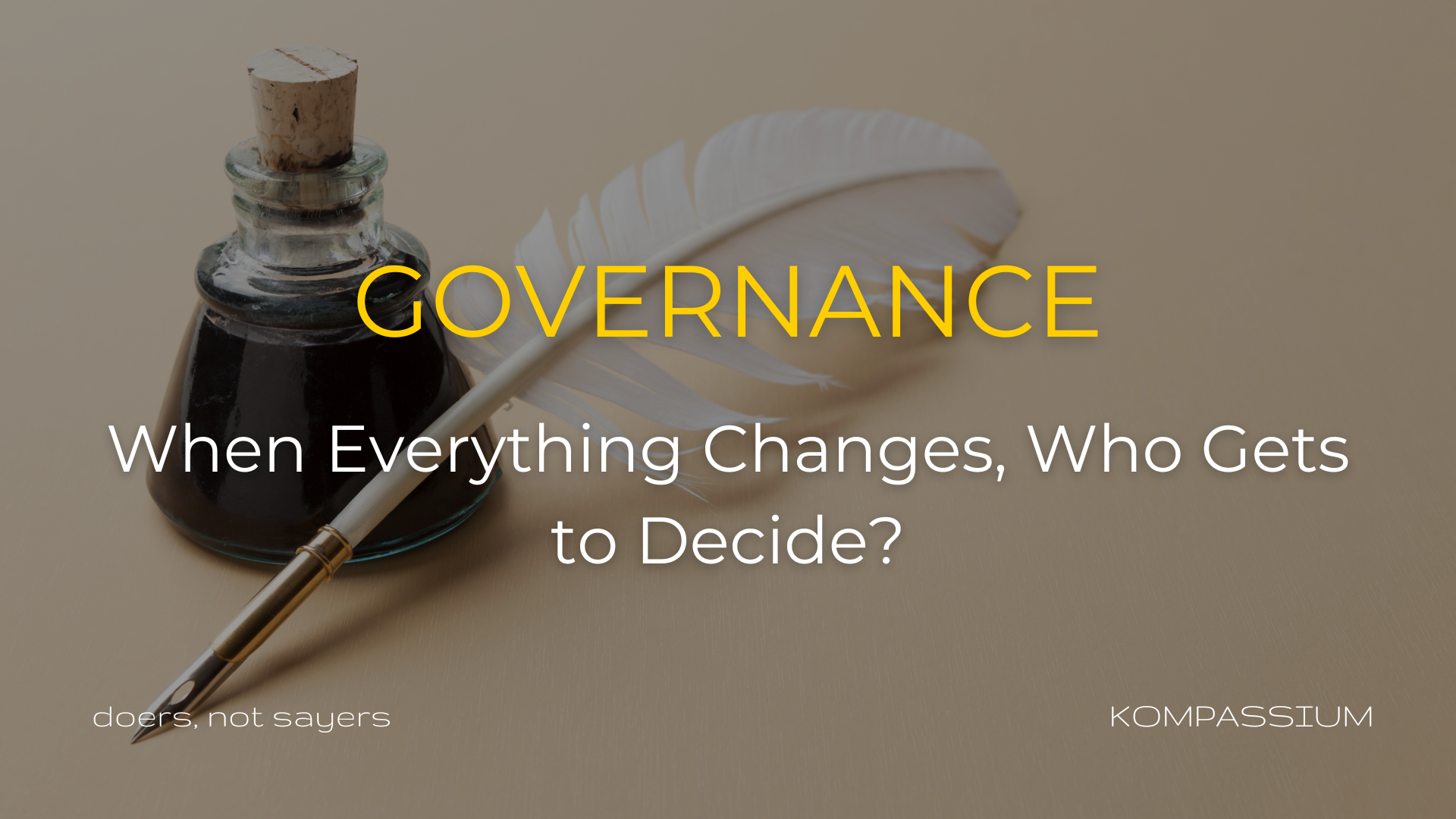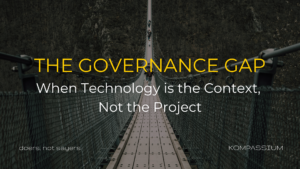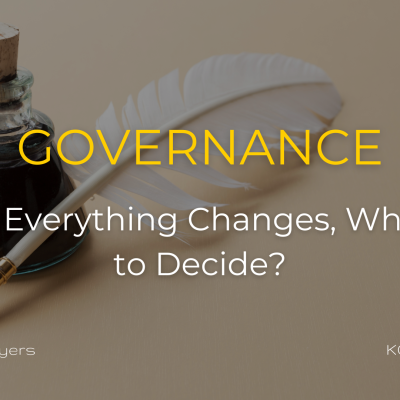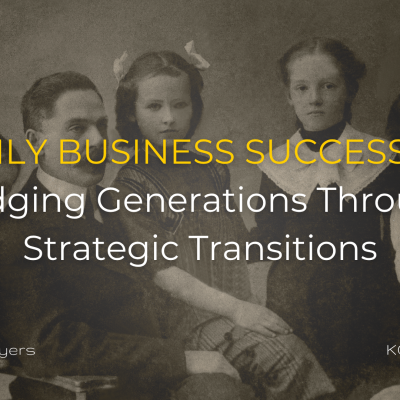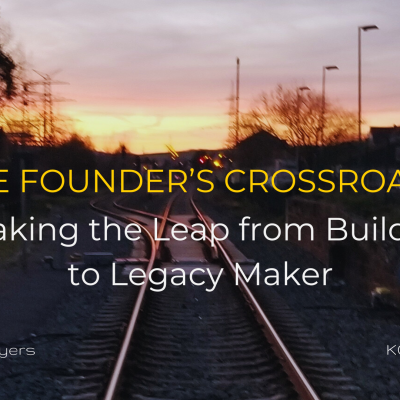Written by Marcos R Leal and Vanessa Alvarez Castillo , members of the network of senior executives and founders at KOMPASSIUM .
Do you need to scale up fast? Is there a potential crisis coming? Is it time to find a new CEO? Do you need to transition your legacy?
Whether you’re about to close a significant joint venture, preparing your company for a strategic acquisition, or facing a generational leadership transition — the kind of change that redefines how your business operates — one question quietly determines what happens next:
Who gets to decide? And who will be the next one to do it?
It’s not a theoretical or philosophical exercise.
It’s operational.
Strategic.
Urgent.
We’ve seen this play out across sectors: high-growth scale-ups suddenly needing structure, mid-market firms entering M&A processes, and family businesses facing generational transition. When everything is moving fast or falling apart, decision—making clarity is the difference between traction and chaos.
These moments of change often surface the latent tensions between the instrumental logic of profitability, the social logic of legitimacy, and the identity logic of organizational purpose. Boards and leadership teams become arenas where these rationalities collide, demanding technical expertise and ethical and anthropological sensitivity.
This article is inspired by 4 cases in which we lived the pains and the dreams of founders.
The Illusion of Alignment
In many companies, roles and responsibilities are assumed rather than defined. This works—until it doesn’t.
Once visiting a large healthcare multi-facility customer, Marcos did what he used to do across Latin America: visiting a customer facility one day before the meeting and “behaving like a patient”. He observed the reception and the coffee and water offered to people. He talked to other patients “like him”. Findings:
The owner’s dreams that he would meet the day after were left decades ago with the initial staff.
As the company grew, communication no longer flowed. The new staff and the expanded business units did not inherit the mission. The inspiring leader or dreamer was still there, but the company lacked a more operational mindset and transparent governance.
A typical example is when a leadership team expands, bringing in new executives to support growth. The founders are still active, but now there’s a COO, a CMO, and maybe an external board member.
Who approves the product pivot?
Who speaks to investors?
Who handles a reputational risk?
What drives the decision to make a potential expansion? Additional revenue or a clear strategy-to-execution mindset?
Without explicit clarity, decisions get delayed, duplicated, or derailed. Worse: they get made in silos, creating internal tension and external confusion.
Clarity is not hierarchy. It’s about knowing who is responsible, accountable, consulted, and informed — and ensuring that the structure evolves as the company grows.
Decision-Making Under Pressure
Vanessa Alvarez, a transformation leader with experience across energy and industrial sectors, puts it:
Pressure doesn’t invent problems; it accelerates the appearance of those already present.
In the past few years, we worked with a manufacturing company operating in a volatile regulatory environment. Unexpectedly, new government restrictions severely limited access to critical imported raw materials, threatening the company’s ability to continue production. The leadership team faced a stark choice: suspend operations until conditions improved or rapidly reformulate their products using locally available alternatives that had historically been avoided due to concerns about competitive positioning. In high-stakes situations, teams fall back on instinct, and instinct often mirrors past roles, not present needs.
Past builds our muscle memories and allows fast responses. However, they are not always the best ones.
The debate was intense. Technical teams worried that switching materials would compromise product standards. Commercial leaders feared that lowering costs and prices could erode market perception and open the door to new competitors. Meanwhile, the finance team stressed the urgency of maintaining cash flow and operational continuity.
Ultimately, the company chose to adapt, but this decision did not come easily, as it was conditioned by the coexistence of deeply held beliefs about the “good way of doing business,” all of which clashed with the urgent need for operational survival. Each stakeholder brought priorities and risk perceptions, making consensus-building difficult and essential. A cross-functional crisis committee was empowered to redesign products using local inputs, streamline processes, and adjust pricing strategies. The company maintained most of its operations and market share through transparent communication and a focus on functional value, even as the competitive landscape shifted.
This experience reinforced a critical lesson:
Under pressure, organizations must balance the need for rapid action with the discipline to weigh trade-offs between profitability, legitimacy, and purpose. Having clear decision-making protocols and the courage to innovate under constraint can turn a potential crisis into a catalyst for resilience.
In these moments, the absence of explicit deliberative frameworks and ethical criteria can lead to decisions that privilege short-term profitability over long-term legitimacy or purpose, sometimes undermining stakeholder trust.
To avoid this, companies must design decision systems before they need them. That means:
- Clear role boundaries at executive and board levels
- Pre-agreed processes for scenario-based decisions (e.g., M&A, crises, pivots)
- Decision logs and visibility mechanisms for accountability
- Deliberative protocols that explicitly address value conflicts and dilemmas, enabling executives and boards to operationalize complexity without falling into instrumental reductionism.
A Real-World Inflection Point
We recently supported a company — name withheld for confidentiality — that had grown rapidly under the passionate leadership of its founder. From humble beginnings, the company reached a few hundred million dollars in valuation, driven by instinct, close relationships, and deep market knowledge. And what a passionate purpose!
Talking to their employees, we saw a rarely seen shared dream. However, everything changed as they prepared for a significant joint venture and potential M&A interest.
What had worked to get them here — highly personalized leadership, gut-driven decisions, informal power structures — became barriers to scale. Important decisions need structure, not intuition. Communication had to become strategic and repeatable. Teams needed clarity, not friendship.
We call it a “building strong process without losing the essence.”
The leader’s role had to evolve — from being “everyone’s big friend” to being an inspiring and directional reference point.
What unlocked this transition? Governance.
By designing a governance model that clarified who decided what (and why), the company could step into negotiations and board-level discussions with confidence, speed, and alignment.
The Hidden Cost of Ambiguity
According to McKinsey, organizations with fast, high-quality decision-making processes are twice as likely to deliver superior financial performance (McKinsey Quarterly, 2019).
Ambiguity doesn’t just slow things down — it creates fatigue. People burn out navigating power dynamics. Teams spin in circles. Execution gets delayed. Opportunities are missed.
When the big shift comes, people jump off the boat, and unintentional sabotage may happen sometimes.
From Ownership to Empowerment
Governance is often seen as the domain of boards and legal frameworks. However, in practice, governance is the operating system of the business. It defines how information flows, how risks are surfaced, and how power is distributed.
Companies that operate with clarity aren’t necessarily rigid. They often enable more speed, autonomy, and innovation because people aren’t waiting for permission. They know their lane and who to go to when the lane ends.
True empowerment emerges when governance systems allow for ethical deliberation and the integration of multiple rationalities-profit, legitimacy, and meaning-into everyday decision-making.
Marcos Leal, co-founder of KOMPASSIUM, reinforces:
We often enter organizations during times of change. The first thing we look for isn’t the strategy. It’s who has the pen. If that’s not clear, no strategy survives.
In smaller companies, for example, owning a process is not about filling out the Hubspot or Salesforce information about the customer. It also means making pushbacks when it is not right, understanding the impact, and being ready to call the leaders to get the commercial team back on track.
What You Can Do Now
Whether you’re leading a startup, a business unit, or a board, here are practical actions you can take:
- Map critical decisions — Where is clarity most urgent? Funding? People? Crisis?
- Define roles — Use frameworks like RACI to make accountability visible.
- Build rituals — Set decision cadences (e.g., weekly governance check-ins, scenario reviews).
- Train for clarity under pressure — Simulate decisions in uncertain contexts.
- Revisit often — As your business evolves, so must your governance.
Final Thoughts
Decisions are the currency of leadership. In a world shaped by complexity and speed, governance isn’t just good practice—it’s a competitive advantage for today’s and tomorrow’s business continuity.
The boards and leaders who thrive will be those who can make visible and negotiate the tensions between what is profitable, what is legitimate, and what is meaningful. Design clarity and deliberative capacity now.
When everything changes, don’t wait for chaos to reveal the cracks.
Design clarity now.
Additional references:
- McKinsey Quarterly, 2019: “The Five Trademarks of Agile Organizations”
- Harvard Business Review, 2022: “The Case for a Chief Decision Officer”
- Interviews with KOMPASSIUM partners and advisors (2023–2025, anonymized for confidentiality)
Marcos Leal is the managing partner at KOMPASSIUM. Vanessa Alvarez is an experienced global executive and a lead advisor at KOMPASSIUM.
